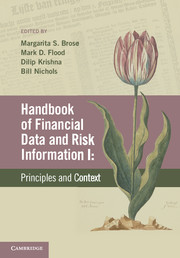Book contents
- Frontmatter
- Contents
- List of contributors
- Preface
- VOLUME I: PRINCIPLES AND CONTEXT
- PART I RISK MANAGEMENT CONTEXT FOR FINANCIAL DATA
- PART II REQUIREMENTS AND SOURCES FOR FINANCIAL RISK MANAGEMENT
- PART III REGULATORY DATA
- 10 A history of financial regulation in the USA from the beginning until today: 1789 to 2011
- 11 Data for microprudential supervision of US banks
- 12 Microprudential supervisory data in the USA: Securities and derivatives
- 13 Financial data and risk information needed for the European system of financial supervision
- 14 Data needed for macroprudential policymaking
- Index – Volume I
- References
12 - Microprudential supervisory data in the USA: Securities and derivatives
from PART III - REGULATORY DATA
- Frontmatter
- Contents
- List of contributors
- Preface
- VOLUME I: PRINCIPLES AND CONTEXT
- PART I RISK MANAGEMENT CONTEXT FOR FINANCIAL DATA
- PART II REQUIREMENTS AND SOURCES FOR FINANCIAL RISK MANAGEMENT
- PART III REGULATORY DATA
- 10 A history of financial regulation in the USA from the beginning until today: 1789 to 2011
- 11 Data for microprudential supervision of US banks
- 12 Microprudential supervisory data in the USA: Securities and derivatives
- 13 Financial data and risk information needed for the European system of financial supervision
- 14 Data needed for macroprudential policymaking
- Index – Volume I
- References
Summary
Introduction
This chapter provides an overview of microprudential data collection and supervision in the securities industry. The origins and development of securities regulation can be found elsewhere in this Handbook. Securities regulation was enacted in the USA to protect individual investors from unfair practices and potential abuses in the public markets, with the foundation of that protection being transparency in the markets, through mandatory disclosures. The concept is two pronged: one, that the act of disclosure itself makes the one disclosing more honest, and two, that by having relevant information available, an investor can make a more informed decision before making an investment. The model developed by the USA has been followed in many other countries.
The disclosure requirements ensure that there is a wealth of data available to investors and to the regulators themselves, who are responsible for enforcing the laws and maintaining fair and orderly markets. Crises and breakdowns in the markets have led to new legislation to ensure the continued transparency that is the hallmark of the capital market system; for example, in 2000, after it was revealed that companies were providing analysts and other insiders with information that investment banks were then sharing selectively with their clients, Regulation FD was enacted to require issuers to simultaneously disclose material information to analysts, large investors and the public.
- Type
- Chapter
- Information
- Handbook of Financial Data and Risk Information IPrinciples and Context, pp. 490 - 519Publisher: Cambridge University PressPrint publication year: 2014



